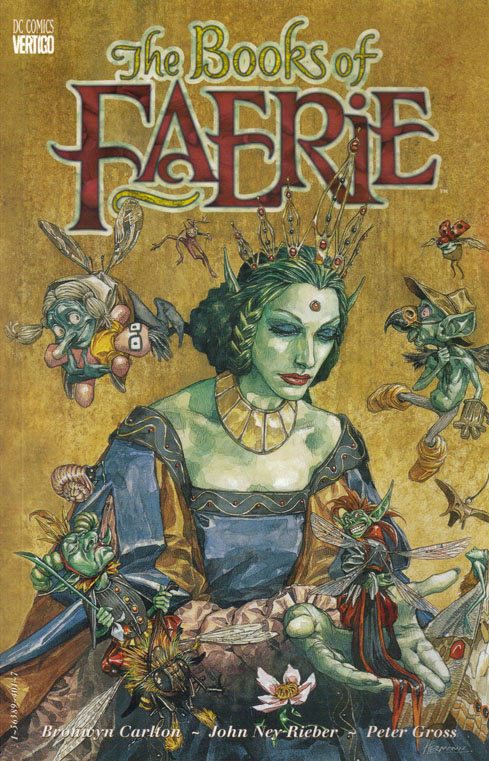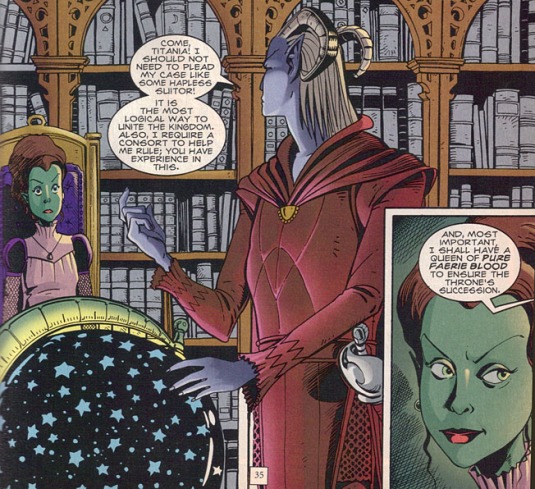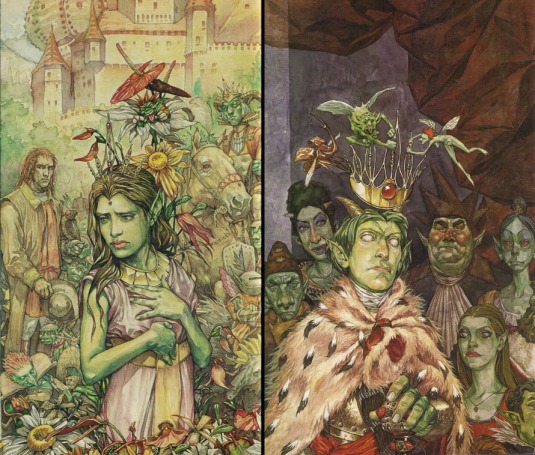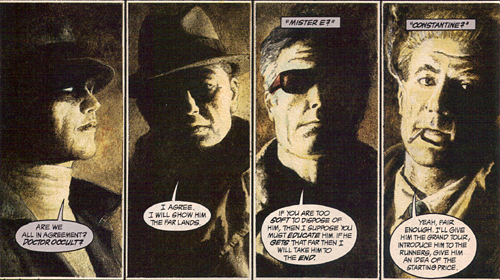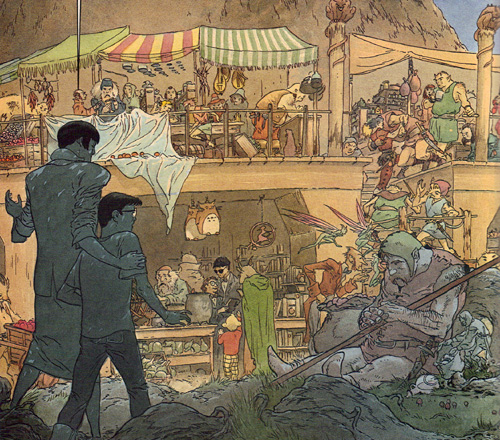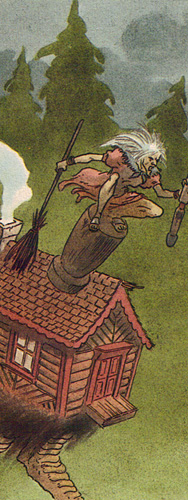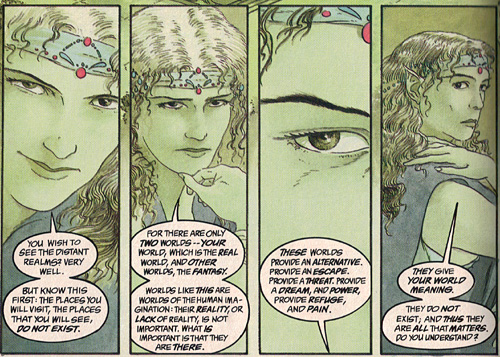by DS Stephen
In 1998, DC Comics released a compilation of the four comics that comprised Stardust (Being A Romance Within The Realm of Faerie), as written by Neil Gaiman and illustrated by Charles Vess. In 2007, a movie based on Stardust was released, directed by Matthew Vaughn. Both works are perfect choices for Fae Awareness Month, since they contain magic and mystical elements that imply fae influence. Herein lies a summary of the book and the movie. I promise not to fall into the trap of denouncing the movie for the book (although, a warning – denouncing the movie on its own merit is fair game).
Stardust (Being A Romance Within The Realm Of Faerie) by Neil Gaiman and Charles Vess
The book Stardust is the story of a young man, Tristran Thorn, and his adventures in Faerie. It’s set in England during the mid-1800s in a universe parallel to our own, in that the narrator name-drops a young Queen Victoria and Charles Dickens, along with photographs and the creation of Morse code. That being established, we’re told of a town called Wall, named for the actual stone wall to which it’s in close proximity. This wall is guarded day and night, and acts as a barrier between England and the Realm of Faerie, a land of nymphs and satyrs, trolls, gnomes, and witches, where fairy tales are just tales. However, every nine years a fair is held in the part of Faerie just beyond the wall, and all and sundry flock to Wall to get the opportunity to cross through the sole gap in the border.
Tristan is half-fae himself, the child of a somewhat hapless young man and a woman of the fae who is bound in servitude to a witch until “the moon loses her daughter, if that occurs in a week when two Mondays come together.” We first meet his father, Dunstan Thorn, who wins the promise his heart’s desire from a gentlemen he houses prior to the fair in Faerie. That turns out to be the bewitching enslaved woman from Beyond the Wall. The two meet up after dark and do the horizontal, and less than a year later a basket housing an infant Tristran Thorn is found near the wall. Fast-forward eighteen years; Tristran is described as a shy lad utterly besotted with a young woman named Victoria Forester. He goes over to the other side of the wall to retrieve for Victoria a fallen star, with the hopes that on his return he and Victoria will marry. Tristan’s father, who has married and has a daughter as well, views Tristan’s journey to the Land Beyond the Wall inevitable. After forbidding Tristran’s venture into Faerie during the fairs, Dunstan accompanies his son to the border before sending him on his way.
We are next introduced to the other players in the story: the brothers of Stormhold, the Lilim, and a star. The eighty-first Lord of Stormhold and his seven sons, named sequentially in order of birth, four deceased (as ghosts) and three alive (Primus, Tertius, and Septimus). The succession of Stormhold only goes to the sole surviving son, so as his sons weren’t able to whittle their ranks down the Lord of Stormhold declares whomever first procures a topaz that contains the Power of Stormhold will be the next ruler. He throws the topaz across the sky and falls dead (otherwise known as “pulling a Jean Grey”), and the three brothers depart. The Power of Stormhold, during its epic trek through the air, seems to knock a star out of the sky. The Lilim, three ancient witches, sense the star’s dislodgement and choose one from among them to pursue it and retrieve its heart. It seems that consuming the heart of a star will revive the Lilim’s youth, and the Lilim who leaves ingests the last bit of youth remaining in order to gain power for her journey. Last, we meet the star, a woman who, quite understandably (and hilariously), says “fuck.”
We return to Tristran, who runs into the “hairy little man” (“HLM” hereafter), a creature who had met Tristran’s father back nineteen years prior in Wall. The HLM immediately picks up something odd about Tristran’s heritage (“I was thinkin’ more of a grandmother who was a famous enchantress, or an uncle who was a prominent warlock, or a brace of fairies somewhere in the family tree.”) The two have a run in with homicidal trees, and Tristan’s newfound ability to find paths and locations in the land beyond Wall saves both their lives. Thankful, HLM gives Tristran new clothing, a chain made of “cat’s breath and fish scales, and moonlight on a mill-pond, melted and smithied and forged by the dwarfs,” and a candle that acts like seven league boots.
The journey on the road continues. Septimus proves his deviousness by killing Tertius by way of poisoned wine, brought to Tertius by a hapless chambermaid prior to a tryst. Primus is established as the more compassionate of the fratricidal pair when he makes sure Tertius’s body is returned to Stormhold before continuing on after the Power of Stormhold. The Lilim, on the other hand, proves herself to be a very bad dime indeed, transforming a poor boy into a goat to make a pair to draw her carriage.
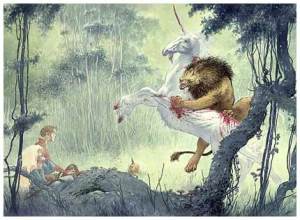 Tristran lights his candle and travels leagues in second. He quickly finds the fallen star, an understandably bitter and angry woman, but he’s unable to get her to go with him before his candle putters out, leaving the two strained about six months of travel away from Wall. He uses the chain that the HLM gifted to him to bind her, and they end up walking (in the case of the star, having broken her leg, limping) towards Wall. During their walk they see a lion and a unicorn engaged in bloody battle, and Tristran, remembering what he’d always believed to be nursery rhyme, saves the unicorn’s life by locating the crown they were fighting over and giving it to the lion. Tristran unbinds himself from the star to go locate food, and it’s on the back of the unicorn that the star escapes.
Tristran lights his candle and travels leagues in second. He quickly finds the fallen star, an understandably bitter and angry woman, but he’s unable to get her to go with him before his candle putters out, leaving the two strained about six months of travel away from Wall. He uses the chain that the HLM gifted to him to bind her, and they end up walking (in the case of the star, having broken her leg, limping) towards Wall. During their walk they see a lion and a unicorn engaged in bloody battle, and Tristran, remembering what he’d always believed to be nursery rhyme, saves the unicorn’s life by locating the crown they were fighting over and giving it to the lion. Tristran unbinds himself from the star to go locate food, and it’s on the back of the unicorn that the star escapes.
The Lilim ends up setting up the means for the survival of Tristran and the star after running into the witch who enslaved the fae woman from the beginning of the story, Madame Semele. Madame Semele tricks the Lilim into sharing her knowledge of the fallen star and the youth that can be retained from consuming the star’s heart, and in retaliation the Lilim curses Madame Semele to not be able to perceive any part of the star and to treat her future guests with more respect. The Lilim’s act of vengeance sows her own failure later on, as we find out.
Tristran ends up traveling with Primus thanks to the intervention of a sympathetic wood nymph. They stop for the night themselves at an inn that was magicked into existence by the Lilim in order to capture the star, stymieing the witch’s plans. The inn is at a mountain pass, magicked into existence by the Lilim with the hopes of catching her and cutting out her heart. The unicorn uncovers the Lilim’s murder plot and warns Tristran, but not before the Lilim kills Primus. Tristran manages to salvage the dregs of his candle, thrusting his hands into a fire and badly burning himself before transporting him and the star out of immediate danger.
The candle escape leaves the two trapped in a cloud. Yvaine and Tristran meet the sky ship captain, Captain Johannes Alberic. Yvaine, the star, shares her name with Tristran for the first time. The two tag along with the captain and his friendly lightening-hunting crew for a bit, getting their respective injuries tended. When they depart the narrator relays in brief a number of adventures Tristran and Yvaine have along their way to Wall. They then run into Madame Semele and her multi-colored bird. Madame Semele, under the influence of the Lilim’s curse, doesn’t see or interact with Yvaine. Semele changes Tristran into a dormouse and transports him and unbeknownst to Semele, Yvaine, to Wall. The two have a close call when Semele crosses paths with the Lilim (who killed Septimus, the last remaining Stormhold prince), but the Lilim’s curse prevents Semele from acknowledging or speaking of Yvaine’s presence in her carriage and the Lilim cannot seem to sense the star.
It’s revealed that Yvaine must deliver the Power of Stormhold to its rightful owner, and that the multi-colored bird was the same woman who was bound to Madame Semele back in the beginning of the story. Tristran goes back through the Wall to his town, where he meets with Victoria. Victoria tells him she is engaged to Mr. Monday and didn’t think Tristran would leave Wall to look for the star. Tristran leaves her to her marriage and husband and then goes to reunite with his family. Yvaine speaks with Victoria on the other side of the Wall (“Your fame precedes you.”) and briefly contemplates suicide by transfiguration into stone (as stars that leave Faerie turn into a meteorite) when she thinks Victoria and Tristran are going to get married. But Victoria then introduces Yvaine to her fiancée with the announcement that “on [the Friday of the wedding breakfast] there will be two Mondays together!”
Tristran and Yvaine, having both met with the continued catalyst of the story and having realized they had a “meet-cute” for a reason, now come together and kiss. This concludes the final portion of Madame Semele’s slave woman’s rules for freedom, and she then announces that she is Lady Una, only daughter of the eighty-first Lord of Stormhold. Lady Una introduces herself to Tristran as his mother, tells him that he is the eighty-second Lord of Stormhold.
Yvaine runs into the Lilim, who is now a shriveled old woman now that she’s used so much of her power. It turns out that the Lilim couldn’t sense Yvaine because Yvaine’s heart was given over to Tristran. The two part with a kiss and go off on their separate ways.
Tristran and Yvaine decide to wander Faerie and have adventures for a number of years, leaving Tristran’s mother as regent until their return. Yvaine, being a star and quite long-lived, rules Stormhold after Tristran’s death. And the story concludes on a bittersweet note, with Yvaine standing on the highest precipice of Stormhold, looking up at her star sisters in the sky.
Stardust, Directed by Matthew Vaughn. Also: Wherein The Writer Apologies In Advance For Snark
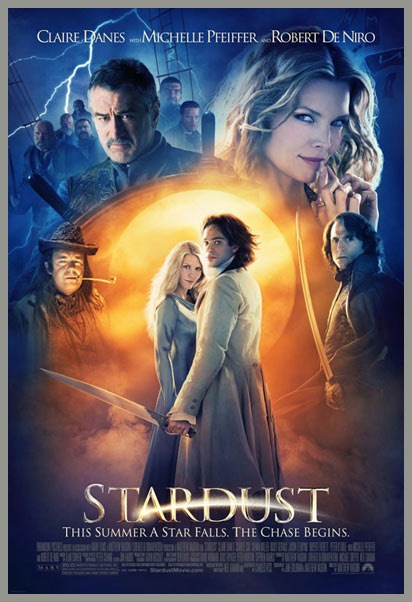
The movie establishes at the beginning by way of graphics and voiceover that belief in fae is not widespread (maybe that’s what the letter Dunstan sends to them is inquiring about? It’s not made very clear, perhaps an omen for the rest of the movie). The town of Wall is located in England, within some proximity to the stone wall from which it takes its name. The Land Beyond the Wall, Stormhold, is particularly intriguing to young Dunstan Thorn, who ends up running past a lone elderly guard into a bustling market. The contents of the market are wondrous (mini-elephants in a cage!), but Dunstan finds himself most enamored with a dark-haired woman tending a cache of crystal flowers for an older woman. The dark-haired woman announces that she is an enslaved princess, who cannot be freed until her captor is dead. When Dunstan asks how he can help console her, the woman takes him into her wagon with amorous intent (“if this wagon is a’rockin…” although one does wonder where the woman’s captor is during this interlude). Soon after (in movie-time), Dunstan is presented with a baby Tristan (because the extra “r” must have irked the studio) Thorn.
The older Tristan we meet an undetermined time in the future is comically awkward and unpopular, even though he’s movie star handsome. He gets relationship advice from his horribly aged father, who’s aware of Tristan’s infatuation with one Victoria Forester, and one would suppose that’s why Tristan ends up outside Victoria’s window with a picnic basket and a bottle of champagne in the wee hours of the morning. In a typical logic-less twist, Victoria goes from a girl who mocks Tristan to one who goes out to dine with him in the wee hours of the morning (pity-fueled midnight picnics?). It’s while the two are imbibing that they see a falling star, and Tristan pledges to bring the star back for Victoria if she’ll promise to marry him. Victoria agrees, and gives Tristan one week to return with the star in tow.
We also meet with the eighty-second Lord of Stormhold and his seven children (four alive, three dead), and three ancient witches. The Lord of Stormhold presents the Ruby of Stormhold, proclaiming that only the rightful heir can change the ruby back to its true form (rubies work better than topazes; who knew?). Only three of his sons (Primus, Tertius, and Septimus) end up leaving the Lord of Stormhold’s chamber in search of the star; Septimus is established as a bad mofo when he pushes Secundus out of a window to his death while the Lord of Stormhold laughs. Tertius meets his end in the palace before then even leave to hunt down the Ruby, poisoned by Septimus while Primus narrowly misses his own death. Michelle Pfeiffer gets screen time next in old crone makeup as one of the witches, speaking with a distractingly bad British accent. She de-ages herself with her sister’s approval and runs off to hunt down the star.
Back in Wall, Tristan goes to his father and tells him of his intention to leave for Stormhold after Tristan’s attempt to leave by way of the gap in the wall comes to naught (old guardian guy has apparently learnt martial arts in the eighteen plus years between Thorn escape attempts; old guardian guy has also aged tons better than Dunstan Thorn). Dunstan tells Tristan that his mother is enslaved somewhere over in Stormhold and that she left him gifts of a BABYLON CANDLE, a chain that can ensnare almost anything, and the crystal flower Dunstan had attempted to purchase all those years prior. Dunstan lights the candle and is immediately transported to the star, who turns out to be Claire Danes in a long blond wig.
Tristan and the star bicker off-and-on for a few scenes. There is a lot of bickering. It’s obvious they’re going to fall madly for one another. The formerly old witch with the bad accent (named Lamia) transfigures a cart led by two goats, and meets up with the witch that has captured Tristan’s mother. The witch, Ditchwater Sal, double-crosses Lamia, and gets cursed. Meanwhile, Septimus continues to demonstrate he’s a bad mofo and kills an old guy.
Tristan ties the star to a tree using the magic binding chain, then goes to find food. A unicorn appears from the forest and frees the star, and the two canter off into the forest. When Tristan comes back to find himself alone he’s more emo than ever. It’s established that Tristan knows the star’s name to be Yvaine because he yells it when he comes back and notices she’s gone. Tristan cries silent tears and curls up under a tree to sleep, but is awakened by the voice of a star who warns him that he must save Yvaine from Lamia. Tristan then has a “meet-cute” with Primus, and the two become travel-buddies.
Yvaine makes her way to Lamia’s transfigured inn-trap, unaware of the danger to her well being (and also her heart). Right before Lamia actually does the deed Primus and Tristan roll up asking for shelter. She then leaves Yvaine and goes to see to her new boarders, because the movie needs to build suspense. Things go as in the book: the unicorn uncovers the trap, Tristan runs in to warn Primus, Primus is killed by Lamia (bleeding blue blood, because I guess a fount of red fluid gushing from carotids would have caused the PG rating to change to a R?), Tristan transports with Yvaine into the clouds using the BABYLON CANDLE (which is apparently a big thing, because it’s been mentioned at least three times by various characters).
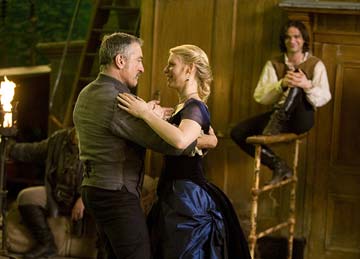 Then some editing intern gets his/her hands on the reels and splices in twenty-five minutes of a vaguely intriguing sky pirate movie into Matthew Vaughn’s adaptation of Stardust. That is the only way to explain the presence of Robert DeNiro’s transvestite Captain Shakespeare and his literally dirty crew of kind-hearted rapscallions. It’s like the only way they could get DeNiro in the movie was to heavily bulk up the role of Captain Alberic from the book, creating an effeminate fashionisto working though paternal issues. The more I ponder it, the more I see the idea behind a character like Shakespeare fascinating on a certain level, but the execution was often painful at best. It seems that the introduction of Shakespeare, in addition to being a vessel for Robert DeNiro to play a pirate in the spirit of Johnny Depp, is a long-winded montage-laden way to show Yvaine and Tristan that they shouldn’t hide who they are and/or their feelings for one another. However, the sky captain section became just that, the Sky Captain section. The little bit of story coherency, in my opinion, was lost to advance the plot (via montages) and the protagonists (one week deadline to make it back to Wall).
Then some editing intern gets his/her hands on the reels and splices in twenty-five minutes of a vaguely intriguing sky pirate movie into Matthew Vaughn’s adaptation of Stardust. That is the only way to explain the presence of Robert DeNiro’s transvestite Captain Shakespeare and his literally dirty crew of kind-hearted rapscallions. It’s like the only way they could get DeNiro in the movie was to heavily bulk up the role of Captain Alberic from the book, creating an effeminate fashionisto working though paternal issues. The more I ponder it, the more I see the idea behind a character like Shakespeare fascinating on a certain level, but the execution was often painful at best. It seems that the introduction of Shakespeare, in addition to being a vessel for Robert DeNiro to play a pirate in the spirit of Johnny Depp, is a long-winded montage-laden way to show Yvaine and Tristan that they shouldn’t hide who they are and/or their feelings for one another. However, the sky captain section became just that, the Sky Captain section. The little bit of story coherency, in my opinion, was lost to advance the plot (via montages) and the protagonists (one week deadline to make it back to Wall).
Shakespeare gifts Tristan with lightening before dropping them off about two days journey outside of Wall (not before a forgettable appearance by Ricky Gervais), which means they’ll get to Wall with just enough time for Tristan to find Victoria and marry her (Tristan has grown long hair and learned how to fight within five days). Dishwater Sal meets up with Tristan and Yvaine, changes Tristan into a dormouse, and takes them close to Wall. During the journey to Wall Yvaine confesses her love for Tristan. When he’s transformed back into a human Tristan at first seems like he might not remember Yvaine’s confession, but he does!
 Then Yvaine and Tristan have sex. But the movie is PG-13 so it’s implied and occurs off-camera. It’s also implied that Tristan is amazing in bed, because Yvaine says she’s had her first night of restful sleep since reaching land. But it turns out she’s speaking to herself, because Tristan’s gone, having left a ambiguous message for Yvaine with the innkeeper telling her than Tristan’s going to Victoria and he’s found his one true love. Because the movie needs angst Yvaine thinks Tristan is leaving her for Victoria, so she heads off towards Wall. Not realizing that she’ll turn into a rock on the other side. Angst! Angst!
Then Yvaine and Tristan have sex. But the movie is PG-13 so it’s implied and occurs off-camera. It’s also implied that Tristan is amazing in bed, because Yvaine says she’s had her first night of restful sleep since reaching land. But it turns out she’s speaking to herself, because Tristan’s gone, having left a ambiguous message for Yvaine with the innkeeper telling her than Tristan’s going to Victoria and he’s found his one true love. Because the movie needs angst Yvaine thinks Tristan is leaving her for Victoria, so she heads off towards Wall. Not realizing that she’ll turn into a rock on the other side. Angst! Angst!
Tristan, after going to Victoria and showing her how much hotter he now is than her current boyfriend, also realizes that Yvaine will turn into a meteorite if she leaves Stormhold. Cue the slow-motion run of Tristan, Tristan’s mother, Septimus, and Lamia, towards Yvaine. Yvaine’s venture out of Stormhold is halted, there’s a skirmish at the border, Dishwater Sal is killed, and Tristan’s mom and Yvaine are taken to the witches’ home.
Septimus and Tristan join forces to storm the castle. Tristan meets his mother for the first time, she reunites with her brother Septimus, and they all gather together just in time for Lamia to torture Septimus to death in a rather grotesque scene. Cue boss battle: Lamia vs. Tristan. They fight, Lamia pulls a fake out where she says she quits, and she totally doesn’t quit. Yvaine kills Lamia after she and Tristan hug it out (I don’t even; I’m guessing the test audiences weren’t happy unless the baddie got her comeuppance). Tristan’s revealed as the heir to Stormhold, it’s voice-overed that he and Yvaine live forever (I’m guessing Tristan dying and leaving Yvaine all alone didn’t fly with test audiences either). And as a coronation present Tristan’s mother gives him and Yvaine a BABYLON CANDLE (she must have stockpiles of the things; also, didn’t Dishwater Sal say they were black magic? (Tristan’s mom = sekrit Big Bad!)
Cue credits.
The End



